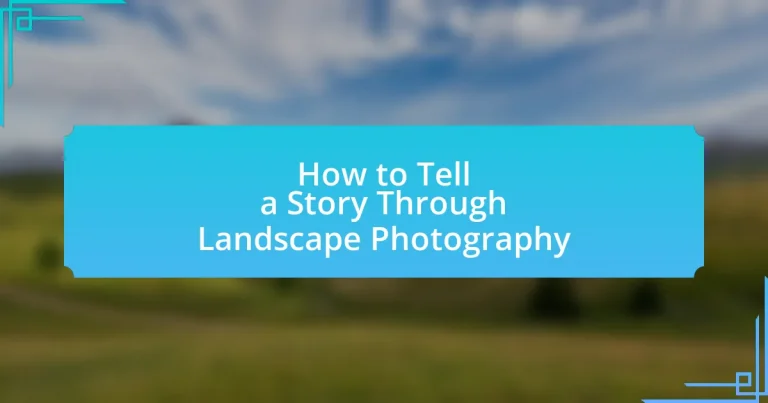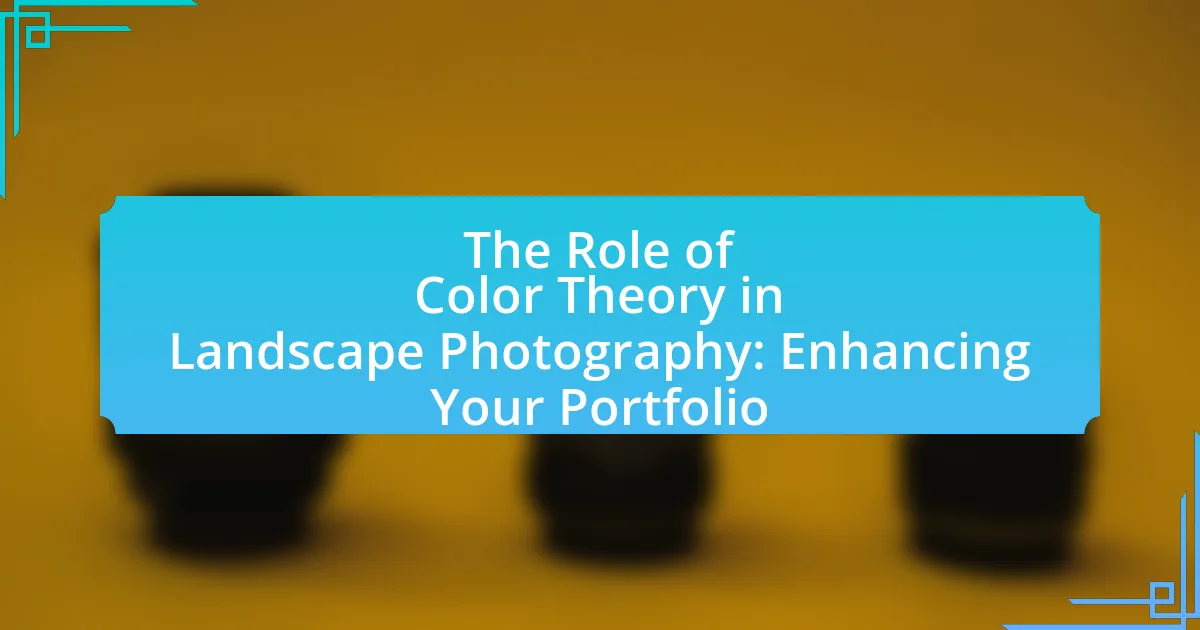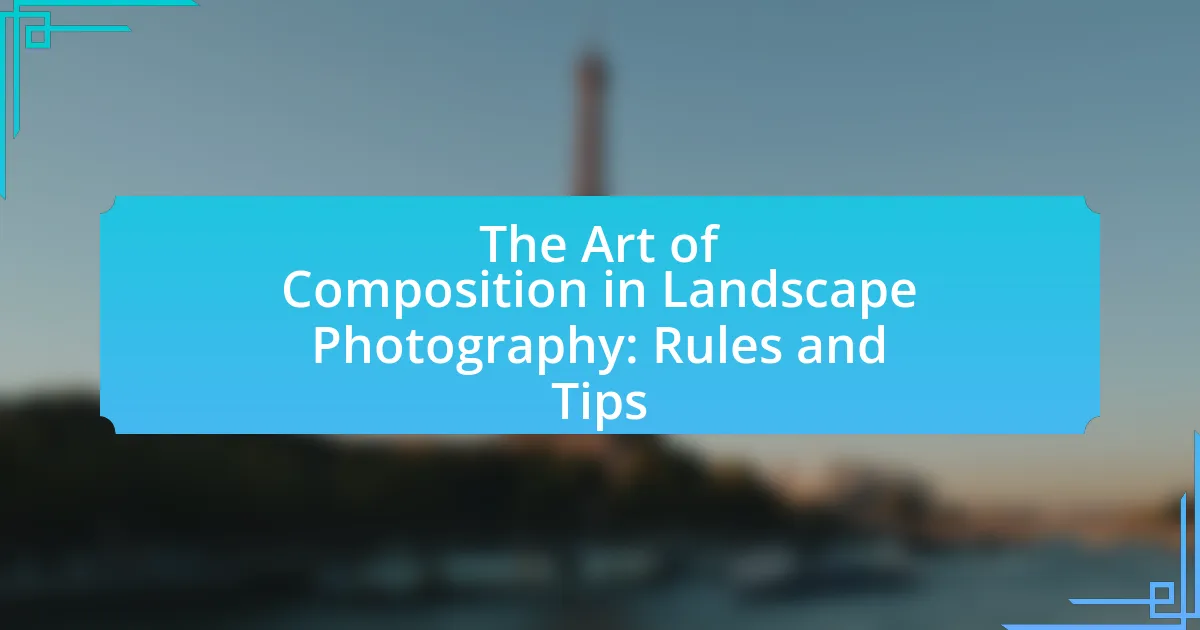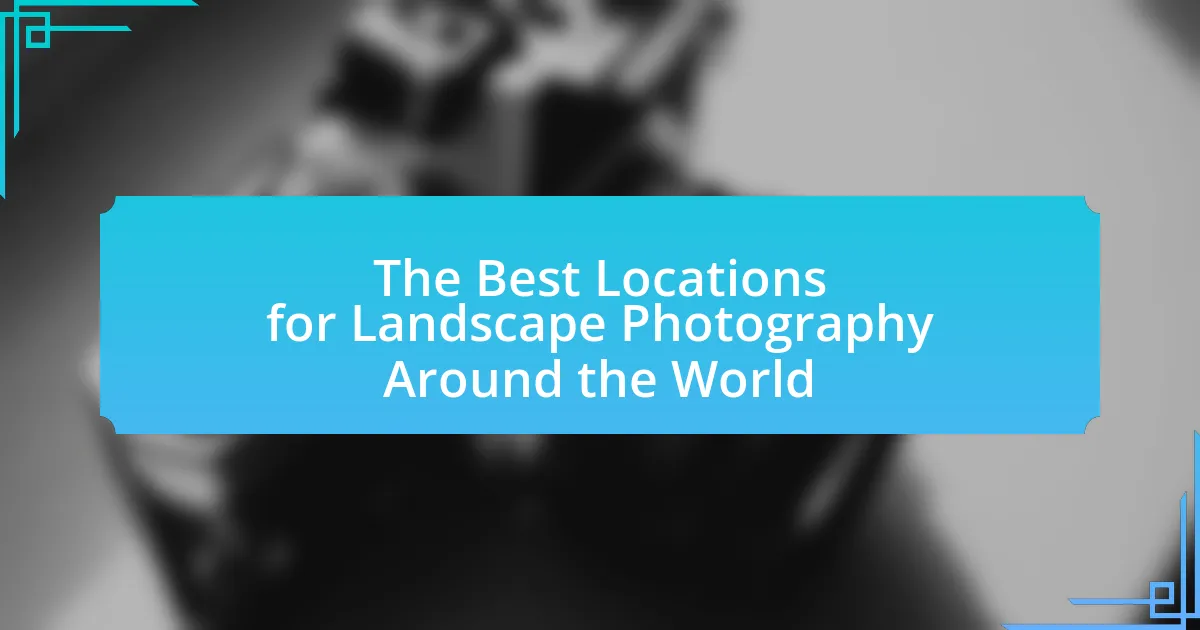The article focuses on the significance of storytelling in landscape photography, emphasizing how it transforms images into narratives that evoke emotions and connections. Key elements such as composition, light, and subject matter are explored, detailing how they enhance viewer engagement and emotional resonance. Techniques like the rule of thirds, leading lines, and effective use of lighting are discussed as essential tools for guiding the viewer’s eye and shaping the narrative. Additionally, the article highlights the impact of post-processing and the importance of perspective in refining the story conveyed through landscape imagery. Overall, it provides practical tips for photographers to develop their storytelling skills and create compelling visual narratives.
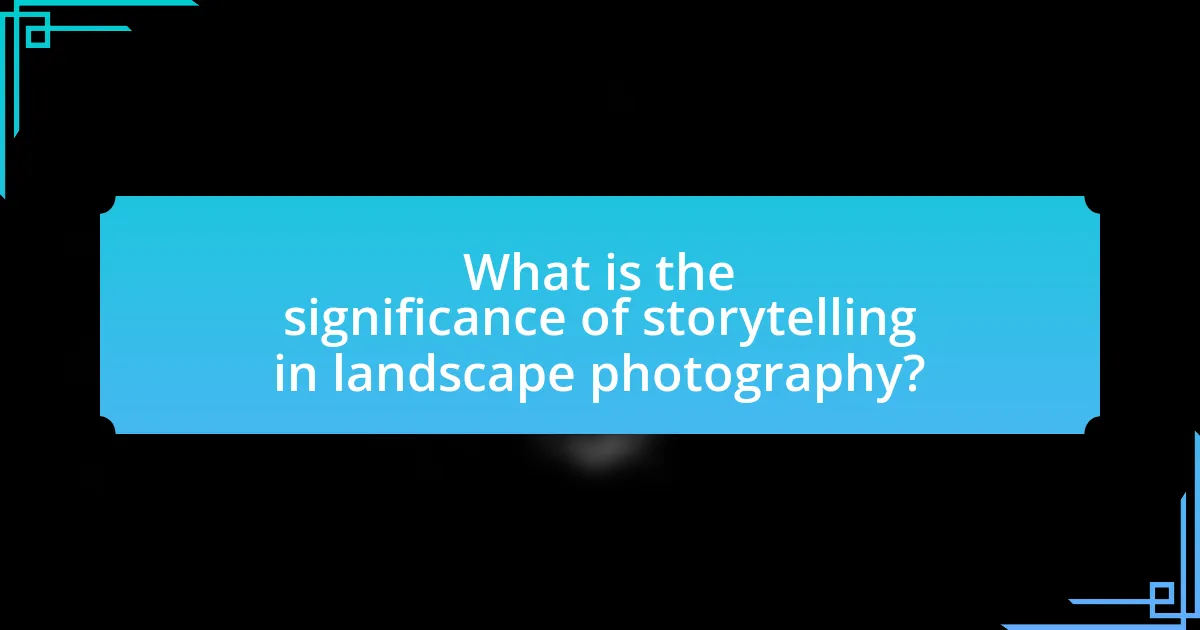
What is the significance of storytelling in landscape photography?
Storytelling in landscape photography is significant because it transforms a mere image into a narrative that evokes emotions and connections. By incorporating elements such as light, composition, and subject matter, photographers can convey themes like solitude, adventure, or the passage of time. For instance, Ansel Adams’ work often tells stories of nature’s grandeur and fragility, highlighting environmental concerns. This narrative aspect engages viewers, prompting them to reflect on their own experiences and relationships with the landscape, thereby enhancing the impact of the photograph.
How does storytelling enhance the viewer’s experience?
Storytelling enhances the viewer’s experience by creating emotional connections and providing context to the visual elements presented. When a narrative is woven into landscape photography, it allows viewers to engage more deeply with the image, as they can relate to the story behind the scene. Research indicates that narratives can activate areas of the brain associated with emotion and memory, making the experience more memorable and impactful. For instance, a photograph of a serene landscape accompanied by a story of personal reflection can evoke feelings of tranquility and nostalgia, thereby enriching the viewer’s overall experience.
What elements contribute to a compelling narrative in landscape photography?
A compelling narrative in landscape photography is primarily contributed by elements such as composition, light, and emotional resonance. Composition guides the viewer’s eye and establishes a focal point, while light enhances mood and atmosphere, often dictating the time of day and weather conditions that can evoke specific feelings. Emotional resonance connects the viewer to the scene, often achieved through the inclusion of human elements or relatable subjects that tell a story. For instance, a photograph capturing a lone tree on a hill at sunset can evoke feelings of solitude and reflection, illustrating how these elements work together to create a narrative that engages the audience.
How can emotions be conveyed through landscape imagery?
Emotions can be conveyed through landscape imagery by utilizing elements such as color, composition, and lighting to evoke specific feelings. For instance, warm colors like reds and oranges can create a sense of warmth or excitement, while cooler colors like blues and greens often evoke calmness or sadness. The composition, including the use of leading lines or framing, can guide the viewer’s eye and influence their emotional response. Additionally, lighting conditions, such as golden hour or dramatic storms, can enhance the mood of the scene. Research indicates that visual elements significantly impact emotional perception, as demonstrated in studies on color psychology and visual storytelling.
Why is composition important in telling a story?
Composition is important in telling a story because it guides the viewer’s eye and shapes their emotional response to the image. Effective composition organizes elements within the frame, creating a visual narrative that enhances the story being told. For example, the rule of thirds can draw attention to focal points, while leading lines can direct the viewer’s gaze through the scene, establishing a sense of movement or journey. Research in visual perception indicates that well-composed images are more engaging and memorable, as they facilitate better understanding and connection with the subject matter.
What compositional techniques can be used to guide the viewer’s eye?
Compositional techniques that can be used to guide the viewer’s eye include the use of leading lines, framing, and the rule of thirds. Leading lines, such as roads or rivers, draw the viewer’s attention toward the main subject, creating a sense of depth and movement. Framing involves using elements within the scene, like trees or arches, to create a visual border around the subject, directing focus. The rule of thirds suggests placing key elements along imaginary grid lines to create balance and interest, enhancing the viewer’s engagement with the image. These techniques are widely recognized in photography and art, as they effectively influence how viewers perceive and interact with visual narratives.
How does the rule of thirds influence storytelling in landscape photography?
The rule of thirds significantly influences storytelling in landscape photography by guiding the composition to create a more engaging visual narrative. This compositional technique divides an image into nine equal parts using two horizontal and two vertical lines, encouraging photographers to place key elements along these lines or at their intersections. By doing so, the viewer’s eye is naturally drawn to focal points, enhancing the emotional impact and storytelling aspect of the photograph. Research indicates that images composed using the rule of thirds are perceived as more balanced and dynamic, which can evoke stronger emotional responses from viewers, thereby reinforcing the narrative being conveyed.
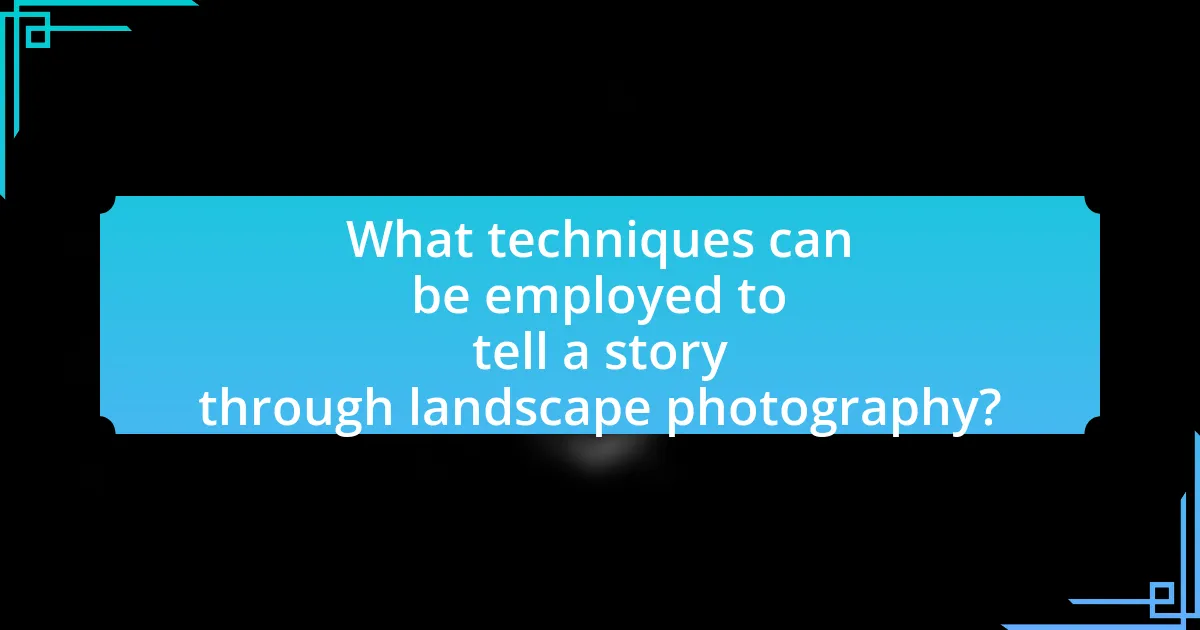
What techniques can be employed to tell a story through landscape photography?
Techniques that can be employed to tell a story through landscape photography include the use of composition, lighting, and subject matter. Composition techniques such as the rule of thirds can guide the viewer’s eye and create a sense of balance, while leading lines can draw attention to focal points within the landscape. Lighting, particularly during golden hour, can enhance mood and evoke emotions, contributing to the narrative. Additionally, selecting specific subject matter, such as weather conditions or human elements within the landscape, can provide context and depth to the story being told. For instance, a photograph capturing a stormy sky over a desolate landscape can convey feelings of isolation or turmoil, effectively narrating a story through visual elements.
How can lighting affect the mood of a landscape photograph?
Lighting significantly influences the mood of a landscape photograph by altering the perception of colors, shadows, and textures. For instance, soft, diffused light during golden hour creates a warm and inviting atmosphere, enhancing feelings of tranquility and nostalgia. In contrast, harsh midday sunlight can produce stark shadows and high contrast, often evoking a sense of tension or drama. Studies in photography, such as those by Ansel Adams, emphasize that the quality of light is crucial in conveying emotion, as it can highlight specific elements within the landscape, guiding the viewer’s emotional response. Thus, the manipulation of lighting is essential for photographers aiming to tell a compelling story through their images.
What are the best times of day for capturing storytelling landscapes?
The best times of day for capturing storytelling landscapes are during the golden hour, which occurs shortly after sunrise and before sunset. During these times, the sunlight is softer and warmer, creating dramatic shadows and enhancing colors, which contribute to the emotional impact of the landscape. Research indicates that the angle of the sun during these hours produces a more dynamic range of light, making scenes more visually appealing and rich in detail. This phenomenon is widely recognized in photography, as it allows for the creation of images that evoke a sense of place and narrative.
How does weather influence the narrative of a landscape image?
Weather significantly influences the narrative of a landscape image by altering the mood, atmosphere, and visual elements present in the scene. For instance, a bright sunny day can evoke feelings of joy and warmth, while a stormy sky may convey drama or foreboding. The presence of fog can create a sense of mystery, obscuring details and inviting viewers to ponder what lies beyond. Additionally, weather conditions such as rain or snow can enhance textures and colors, making the landscape appear more vibrant or subdued. Research indicates that emotional responses to images are often linked to environmental cues, suggesting that the weather depicted in a landscape image plays a crucial role in shaping the viewer’s interpretation and emotional engagement with the scene.
What role does perspective play in storytelling?
Perspective plays a crucial role in storytelling by shaping how a narrative is perceived and understood. It influences the emotional engagement of the audience, as different perspectives can evoke varying responses and interpretations of the same events. For instance, a first-person perspective allows readers to experience the protagonist’s thoughts and feelings directly, creating intimacy, while a third-person perspective can provide a broader view of the story’s context and multiple characters’ motivations. Research in narrative psychology indicates that perspective affects empathy and connection; studies show that readers are more likely to empathize with characters when the narrative is presented from their viewpoint. Thus, perspective not only guides the audience’s understanding but also enhances their emotional investment in the story.
How can different angles change the story being told?
Different angles can significantly alter the narrative of a landscape photograph by influencing the viewer’s perception and emotional response. For instance, a low-angle shot can evoke a sense of grandeur and majesty, making the landscape appear more imposing, while a high-angle shot can create a feeling of vulnerability or insignificance in relation to the environment. Research by visual perception experts indicates that the angle of view affects not only the composition but also the psychological impact of the image, as different perspectives can highlight various elements of the scene, such as foreground details or expansive backgrounds. This manipulation of perspective allows photographers to convey distinct stories and emotions, ultimately shaping the viewer’s interpretation of the landscape.
What are the effects of foreground, middle ground, and background in composition?
Foreground, middle ground, and background in composition significantly influence the visual narrative and depth of landscape photography. The foreground establishes the initial point of interest, drawing viewers into the scene and creating a sense of scale and context. The middle ground serves as a transitional space that connects the foreground to the background, often containing key elements that guide the viewer’s eye through the composition. The background provides context and atmosphere, often setting the mood or theme of the photograph. Together, these three layers create a cohesive and engaging story, enhancing the overall impact of the image.
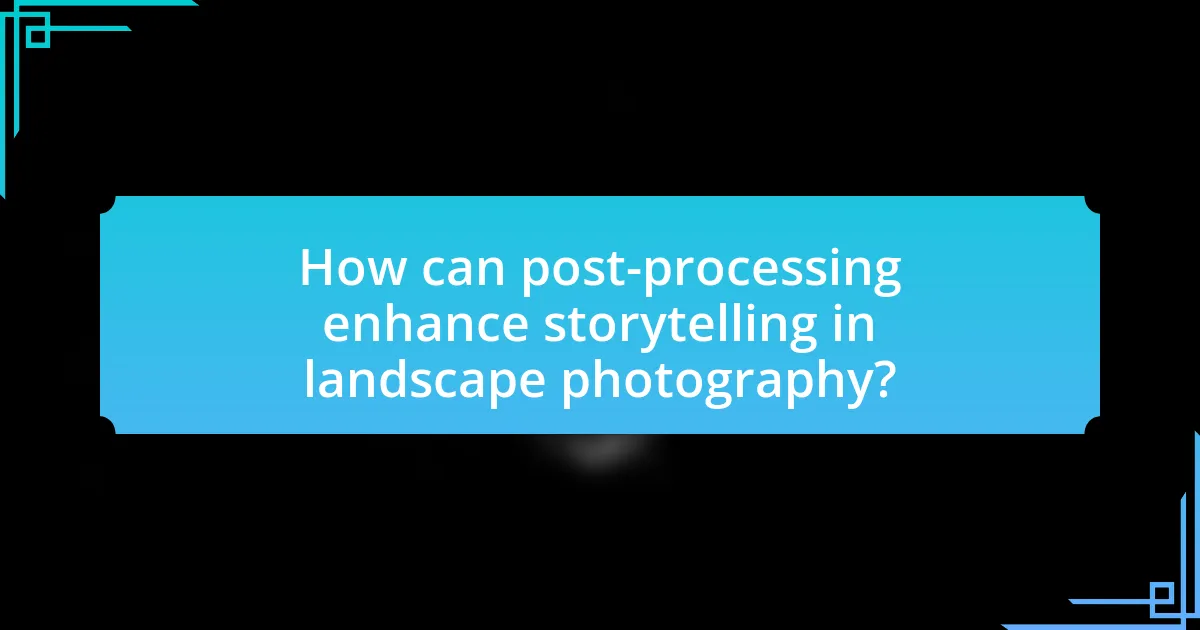
How can post-processing enhance storytelling in landscape photography?
Post-processing enhances storytelling in landscape photography by allowing photographers to manipulate elements such as color, contrast, and sharpness to evoke specific emotions and narratives. This technique enables the photographer to emphasize certain aspects of the landscape, guiding the viewer’s attention and shaping their interpretation of the scene. For instance, adjusting the color saturation can create a mood—vibrant colors may convey joy or vitality, while muted tones can evoke melancholy or tranquility. Additionally, techniques like dodging and burning can highlight focal points, further directing the viewer’s gaze and enhancing the overall narrative. Studies show that images with intentional post-processing are more likely to engage viewers emotionally, reinforcing the story the photographer aims to tell.
What editing techniques can emphasize the narrative of a photograph?
Editing techniques that can emphasize the narrative of a photograph include color grading, cropping, and the use of contrast. Color grading can evoke specific emotions and set the mood, as seen in cinematic photography where warm tones may suggest nostalgia while cooler tones can imply detachment. Cropping allows the photographer to focus on key elements, guiding the viewer’s attention to the most important aspects of the story being told. Additionally, manipulating contrast can highlight specific details or create a sense of depth, enhancing the overall impact of the image. These techniques are widely recognized in photography as essential tools for storytelling, as they help convey the intended message and emotional resonance of the photograph.
How can color grading influence the emotional impact of a landscape image?
Color grading can significantly influence the emotional impact of a landscape image by altering the mood conveyed through color tones and contrasts. For instance, warm tones like oranges and yellows can evoke feelings of warmth and nostalgia, while cooler tones such as blues and greens may create a sense of calm or melancholy. Research indicates that color psychology plays a crucial role in how viewers perceive emotions in visual art; for example, a study published in the journal “Color Research and Application” by researchers from the University of California found that specific colors can trigger distinct emotional responses. Thus, effective color grading can enhance storytelling in landscape photography by aligning the visual elements with the intended emotional narrative.
What role does cropping play in refining the story of a photograph?
Cropping plays a crucial role in refining the story of a photograph by eliminating extraneous elements and focusing the viewer’s attention on the main subject. This technique enhances the narrative by guiding the viewer’s gaze and emphasizing key details that contribute to the overall message. For instance, a study by the University of California found that cropping can significantly alter the perceived emotional impact of an image, demonstrating that strategic framing can evoke stronger responses from viewers. By removing distractions, cropping helps to clarify the intended story, making it more compelling and easier to interpret.
How can photographers develop their storytelling skills?
Photographers can develop their storytelling skills by practicing visual narrative techniques, such as focusing on composition, light, and subject matter to convey emotions and themes. Engaging with diverse subjects and environments allows photographers to explore different perspectives and contexts, enhancing their ability to tell compelling stories through images. Research indicates that photographers who analyze their work and seek feedback from peers improve their storytelling capabilities, as this reflective practice fosters a deeper understanding of narrative elements in photography.
What practices can help improve narrative skills in landscape photography?
To improve narrative skills in landscape photography, photographers should practice visual storytelling techniques, such as focusing on composition, using leading lines, and incorporating foreground elements. Composition helps to guide the viewer’s eye and establish a sense of place, while leading lines can create depth and draw attention to the main subject. Including foreground elements adds context and enhances the story being told. Additionally, studying the works of renowned landscape photographers can provide insights into effective narrative techniques, as their images often convey emotions and stories through careful selection of subjects and settings.
How can studying other photographers enhance storytelling abilities?
Studying other photographers enhances storytelling abilities by exposing individuals to diverse techniques and perspectives in visual narrative. By analyzing the composition, lighting, and subject matter used by various photographers, one can learn how to convey emotions and messages effectively through imagery. For instance, renowned photographers like Ansel Adams and Edward Weston have demonstrated how the interplay of light and shadow can evoke specific feelings, thereby teaching others to manipulate these elements in their own work. This practice not only broadens a photographer’s creative toolkit but also fosters a deeper understanding of how visual elements can be orchestrated to tell compelling stories in landscape photography.
What are some practical tips for telling a story through landscape photography?
To tell a story through landscape photography, focus on composition, lighting, and subject matter. Composition involves using techniques like the rule of thirds to create balance and draw the viewer’s eye to key elements, enhancing narrative depth. Lighting, particularly during golden hours, adds mood and emotion, influencing how the landscape is perceived. Subject matter should evoke a specific feeling or theme, such as solitude or adventure, which can be reinforced by including human elements or wildlife. These strategies are supported by studies showing that well-composed images with strong lighting and relatable subjects engage viewers more effectively, making the story conveyed through the photograph more impactful.












